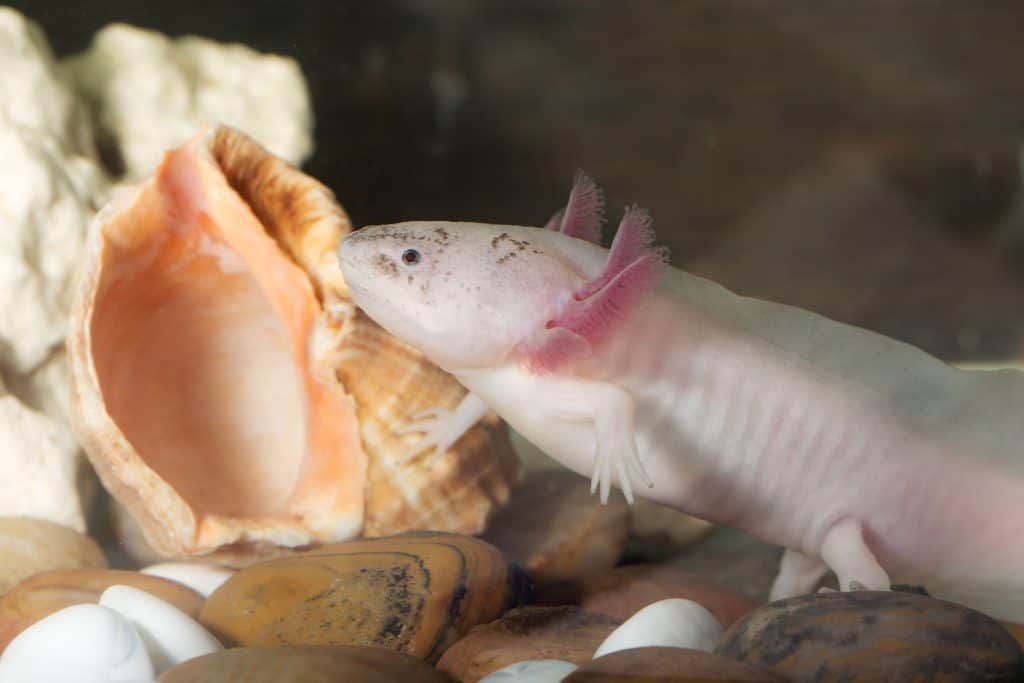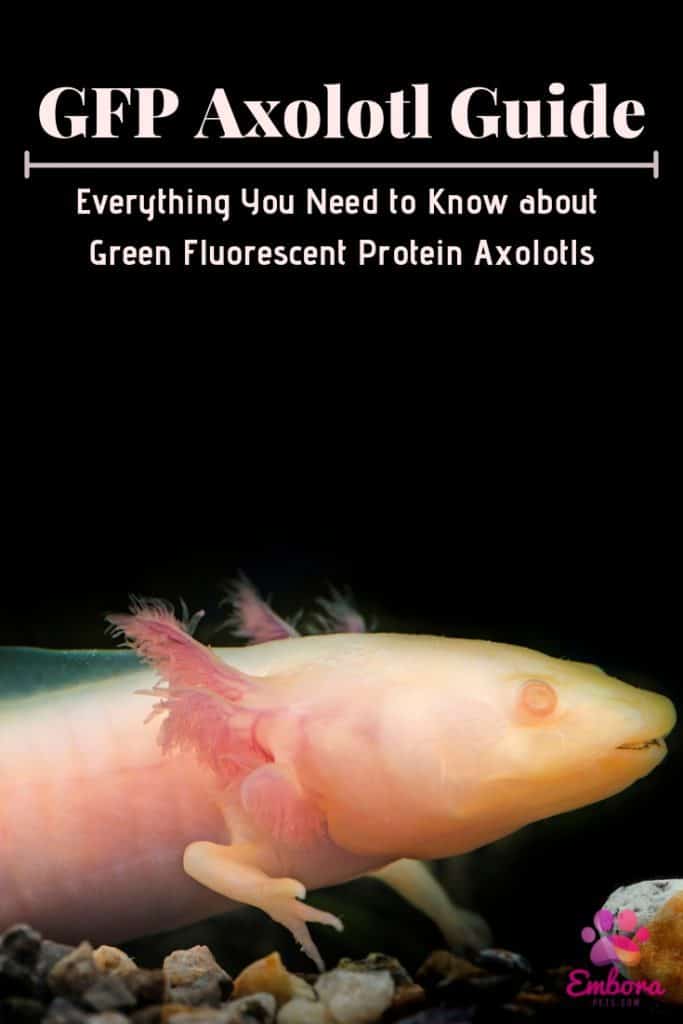GFP Axolotl: A Beginner’s Guide with Pics, Cost to Buy, and Care Info
Axolotls are a cool amphibious pet option that
How do you take care of a GFP axolotl?
GFP axolotls are no different to care for than any other axolotl. However, they cost $70 on average, which is about $40 more than the cost of a wild or normal albino axolotl. You’ll want a 20-gallon tank for your axolotl, with filtered water kept between 58 to 67 degrees Fahrenheit.
Besides their cool looks and high prices, GFP axolotls are no different from a normal axolotl, so caring for them is the same as usual. This doesn’t mean it’s simple, though. Axolotls are happy creatures that require very specific living conditions to survive. They have a rather extensive care list.
Cost to Buy a GFP Axolotl
GFP Axolotls look really, really cool. These creatures are already adorable, but to be able to see through their body when they are under UV or black light just makes them cooler. This comes at a price. On average, you’ll be spending $50 more for a GFP Axolotl than a normal axolotl.
The difficulties continue. While axolotls are not uncommon, GFP Axolotls don’t just pop up everywhere. You’ll need to find the right places that sell these critters. One difficulty that arises here is who you can trust online.
There are a lot of online traders that don’t have your best interests at heart, so finding trustworthy resources is a challenge. That being said, here are a few starting options: Caudata.org, ReptilesNCritters, and Axolotl Factory.
Axolotls are frequently sold through private breeders, which means you’ll likely be able to negotiate and lower the price if you think the price they’re asking for is too high.
If you can find an exotic pets dealer near you then you can do this in person. As this is unlikely, you’ll probably need to take this discussion online to barter for the price of the axolotl.
When negotiating/looking for good deals on axolotls, be aware that juvenile axolotls will be significantly cheaper than adult axolotls. This is because juvenile axolotls are harder to care for, so you’ll need to put in more effort if you end up going with a younger option.
Basics of Axolotl Care
When it comes to axolotl care, you will want to pay particular attention to the axolotl’s tank, water, and food. These three areas are where the biggest problems that axolotls face often start.
Tank Management
Tank size is important to an axolotl. They like space to roam around, as well as a varying amount of terrain to hide in and escape to from things like sunlight.
Axolotls can grow anywhere from 6 to 18 inches in length. This means you’ll probably want to aim for a 20-gallon tank per axolotl. A tank like this one could work for you.
This is particularly important when you have more than one axolotl, as they have cannibalistic tendencies that are more prevalent when confined to small spaces.
Tank Lid
Whatever size of tank you go with, get a tank lid. Axolotls have a natural reaction to jump out of the water when they are scared. If there is no lid, the axolotl will jump out of the tank.
Axolotls cannot live outside of water, so if they jump out of the tank while you’re gone they can be severely injured. Avoid this. Get a tank cover.
Substrate
Another major tank detail that you should consider is what tank covering you will use. Tank covering or substrate is used to cover the bottom of your tank. This is particularly important for axolotls because they need the help of substrate to crawl across the ground. Plain glass it too slippery for them.
Without the proper substrate, an axolotl will have higher stress, which can grow into a whole load of medical problems which are caused by their inability to move as they desire.
Pro Tip: Use turtle rocks for axolotl tanks and it will protect them better and make it easier for them to move around!
When choosing substrate for your tank, stick to either a very finely-grained substrate (such as sand), or very large rocks/gravel. You want to avoid anything small enough for an axolotl to eat which might block its digestive track. An axolotl will eat its substrate if it can. Small pebbles are one of the leading causes of health issues in axolotls because of this.
Water Conditions

Axolotls are used to their home environment, which means filling your tank up with tap water is not going to fill the bill here. If your water is too high in toxicity or it is unclean, or if it is the wrong temperature for the axolotl, they will get very sick and can even die as a result.
For a simple solution here, use bottled water. Bottled water is purified water that comes from natural sources. This is the easiest option, and you won’t have to worry about filtering the water you put into the tank.
You may still want to check its chemical and PH content, but it’ll be much less of a problem than tap water.
If you do end up using tap water, really watch out for ammonia and chlorine. Neither of these is good for your axolotl, so remove them! You can dechlorinate your water through a filter or by using a dechlorinating solution. You can also leave the water out in the open for 24 hours to allow the chlorine to dissipate.
Try to keep the water chemistry within the following parameters:
- Acceptable PH levels: 6.5 to around 8.0
- Ideal PH levels: 7.4 to 7.6
- Ammonia Levels: 0ppm (Anything over 1ppm can kill your axolotl)
- Nitrite level: 0ppm (Same as ammonia, 1ppm or more is deadly)
- Nitrate levels: 2ppm to 40ppm (anything higher is toxic. 20% water changes to stop this level rising to toxic levels)
Check out exopetguides for more information like this list.
Cleaning the Tank
One of the biggest producers of ammonia in a tank is the excrement of the axolotl. You’ll need to play an active roll in removing the waste of your axolotl or have a filter that can take care of that for you.
Not taking care of an axolotl’s dirty water will result in major illness, if not death, from this chemical imbalance.
Temperature
The optimal temperature for axolotl water is 60 to 64 degrees Fahrenheit (16 to 18 degrees Celsius). However, water within the temperatures of 55 to 70 degrees is generally going to be fine, as well.
The optimal temperature for axolotl water is 60 to 64 degrees Fahrenheit.
The temperature of the water can do some strange things to the axolotl, but mainly it affects the axolotl’s metabolism. The colder the water, the slower the axolotl’s metabolism, and the hotter the water, the faster its metabolism.
Water that is too hot will result in axolotl’s death. If it is too cold, it will eat less and is generally safe but may get harmed due to the low temperatures of the water itself.
Food for Axolotls
Axolotls have a lot of food options. There are quite a few food options that you can get for your axolotl.
Among the best options available are:
- Worms
- Snails
- Crustaceans
- Small Fish
- Brine Shrimp
- Salmon Fish Pellets
Out of the food options listed above, the cheapest options are the salmon fish pellets and worms. Both of these are available in bulk sizes. Small fish are also a very convenient way to feed the axolotl, as long as they aren’t large enough to bite the axolotl.
The axolotl will eat the food whenever it is hungry. You can use
One quick word of caution here: don’t feed your axolotl worms or fish that you have caught yourself. They may contain parasites or viruses that can be transferred to your axolotl!
Bonus Tip: This Axolotl food gets 4.5 Stars on Amazon and comes in 7 different sizes!
Related Questions
Are axolotls good pets?
Axolotls are very friendly pets that require very specific living conditions. If you have the means to meet those living condition for the axolotl then they will be great pets. If you can’t meet those expectations you will be hurting the axolotl more than helping it.
Do axolotl play well with others?
Axolotls should not be set in a tank with anything other than another axolotl, and even that is questionable. Axolotls will almost always eat and be attacked by whatever creature is kept in the tank with it. Don’t keep other aquatic animals with an axolotl.

